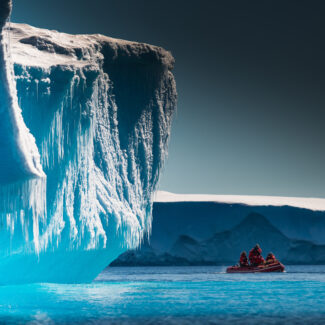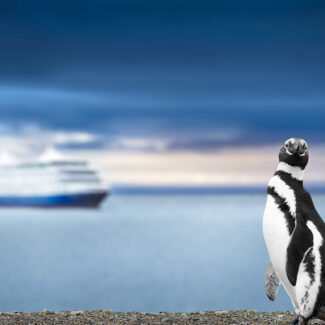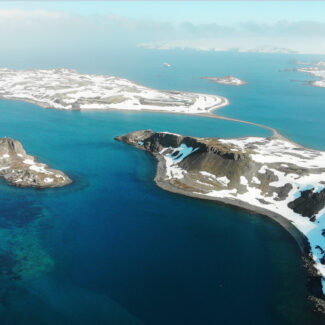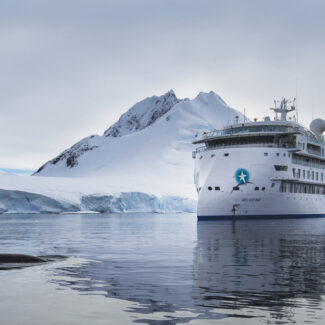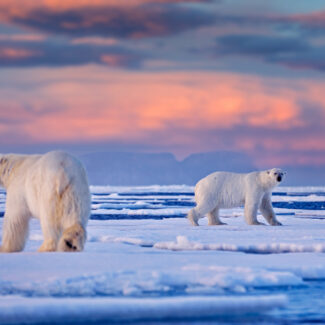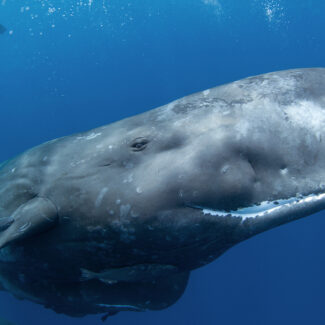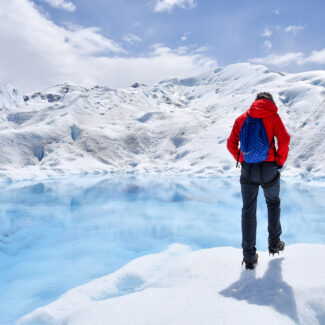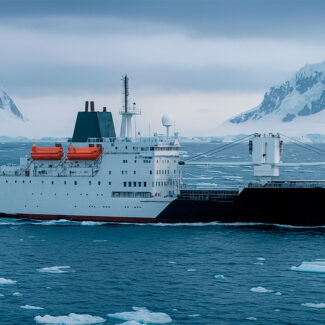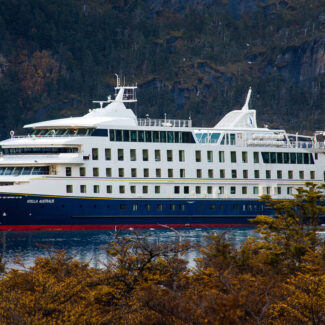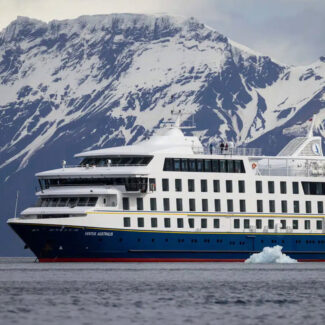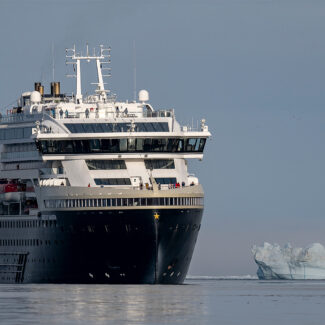The Search For The Northwest Passage: An Exploration History
- Why is the Northwest Passage Important?
- First Nations Legacy
- Exploration History of the Northwest Passage
- John Cabot
- Jacques Cartier
- Martin Frobisher
- John Davis
- George Weymouth
- Henry Hudson
- Other 17th & 18th Century Attempts
- William Parry
- John Ross
- John Franklin
- Robert McClure: First Northwest Passage Transit
- Roald Amundsen & the First Crossing of the Northwest Passage by Ship
- Later Achievements
- The Northwest Passage Today
Since the time of the Ancient Greeks, those of geographic—and, all the moreso, commercial—persuasion dreamed about an efficient passageway from the Atlantic to the Pacific: a connection between Europe and East Asia. Such a corridor exists: the legendary Northwest Passage through the Canadian High Arctic.
This remote seaway exacted a demanding toll on those seeking it out amid the ice floes and frigid channels—and, today, shows increasing potential as a commercial shipping route while dazzling cruisegoers with spectacular scenery, native Arctic culture, and a stirring sense of historical adventure.
In the following chronicle, we’ll discuss better than three centuries of expeditions and who found the Northwest Passage ultimately.
For centuries, the dream of a navigable shortcut across the top of North America captivated explorers. This 1765 globe by Guillaume Delisle even depicts a fictional Northwest Passage, highlighting the enduring hope and geographical guesswork that fueled this epic quest through history.
Source: Minnesota Historical Society, CC BY-SA 3.0 <https://creativecommons.org/licenses/by-sa/3.0>, via Wikimedia Commons
Why is the Northwest Passage Important?
The Northwest Passage describes the Arctic Ocean sea lane winding through the Canadian Arctic Archipelago, which includes tens of thousands of islands (some truly enormous ones among them) accounting for some of the most extensive terra firma north of the Arctic Circle. It connects the Labrador Sea on the North Atlantic side with the Beaufort Sea on the west, which leads to the Bering Strait (between Alaska and Russia) and to the North Pacific.
Navigators coveted the idea of such a route because of the vastly shorter journey it offered between Europe and the eastern coast of Asia—including busy trading ports in China and India—as compared to maritime routes rounding the southern tip of South America (Cape Horn).
Christopher Columbus’s 1492 voyage revealed to Europe the existence of a continent in between European ports and East Asia, and from then on explorers sought a water route through or around it—an effort that partly coincided with similar quests to trace a Northeast Passage through the Eurasian Arctic.
This historical chart hints at the vast, unforgiving geography that confronted early polar explorers. Their courageous yet ultimately tragic attempts to navigate these icy realms serve as powerful reminders of the Arctic’s perilous nature.
First Nations Legacy
This article mainly focuses on documented efforts by European mariners and explorers to find the Northwest Passage. But we can’t proceed any further without noting that the Inuit and other native peoples long knew the convoluted waterways within the Arctic Archipelago, and they and their ancestors were surely the first to cross the Passage, long before white people ventured here.
Exploration History of the Northwest Passage
The following is a select roundup—most definitely not exhaustive—of some of the most notable documented Northwest Passage expeditions, beginning at the close of the 15th century.
John Cabot
In May 1497, John Cabot—a Venetian navigator under the employ of England—set off from Bristol on the first organized expedition aimed at the Northwest Passage. Aboard the Matthew, Cabot and his crew made landfall in a “new found land”—somewhere on the far northeastern coast of Canada, perhaps the island of Newfoundland, Cape Breton Island, or the mainland shores of Nova Scotia or Labrador—which was initially assumed to be Asia.
Cabot embarked on another voyage to the New World in 1498, the fate of which is shrouded in some mystery. A storm forced one of the expedition ships to shelter in Ireland, but Cabot continued on. Whether he was lost at sea, successfully returned to North American shores, and/or returned to Europe is unknown.
Jacques Cartier
In the mid-1530s and early 1540s, the French explorer Jacques Cartier conducted a series of expeditions to eastern Canada’s coastline and up the St. Lawrence Seaway and St. Lawrence River. Venturing as far as the Lachine Rapids of present-day Montreal, Cartier ended up suggesting, based on information from the local Iroquois people, a mighty river not far west might lead directly to the Pacific.
(The notion of a fairly straightforward river route across the North American interior drove much exploration in parallel with the search for the Northwest Passage. It wasn’t until Captains Meriwether Lewis and William Clark—leading the Corps of Discovery up the Missouri River and then on to the Columbia River under orders from American President Thomas Jefferson in 1803-1806—found the Continental Divide to be nested within the extensive rugged fortress of the Rocky Mountains that that particular dream was firmly put to rest.)
This Spanish chart, dating back to around 1541, offers a glimpse into the early European understanding of the Saint Lawrence River, a key area explored by Jacques Cartier in his search for a westward passage. The somber note near “isla de Orliens” hints at the harsh realities faced by these early French expeditions.
Source” Anónimo, siglo XVI, España, Public domain, via Wikimedia Commons
Martin Frobisher
Englishman Martin Frobisher made a trio of voyages to Canada in search of the Northwest Passage between 1576 and 1578, sponsored by the Muscovy Company (which oversaw extensive trade between England and Russia). These were the first such expeditions to actually enter Arctic waters.
Along with Resolution Island and the entrance to what became later known as Hudson Strait, Frobisher mapped the bay on the southern coast of Baffin Island that now bears his name—a body of water the explorer initially hoped was a portal into the Passage.
(Frobisher had testy interactions with the native Inuit, who ended up kidnapping five of his men on the first voyage.)
This vivid illustration captures a moment from Martin Frobisher’s voyages, showcasing the early encounters between European explorers and the Indigenous peoples of the Arctic during the relentless quest for the Northwest Passage.
Source: John White, Public domain, via Wikimedia Commons
John Davis
Another British navigator of the Elizabethan era (and inventor of the revolutionary Davis quadrant for determining latitude), John Davis also made three expeditions for the Northwest Passage in quick succession: in 1585, 1586, and 1587.
These expeditions made significant strides in expanding Western knowledge of the eastern North American Arctic: Davis further described the entrance to Hudson Strait, explored and named Cumberland Sound along the southeastern coast of Baffin Island, and penetrated the mighty strait between Baffin Island and Greenland that came to bear his name. Sea ice thwarted his northward progress into Davis Strait, which—connecting as it does the Labrador Sea and Baffin Bay—offers the most direct eastern entryway into the Northwest Passage.
George Weymouth
The English explorer George Weymouth made two attempts to find the Northwest Passage in the early 17th century. On the first of these—the voyage of the Discovery and the Godspeed, which departed England on May 2, 1602—Weymouth led his crew 100 leagues (482 km/300 mi) up the Hudson Strait before turning back.
Henry Hudson
The English navigator Henry Hudson made multiple attempts to chart a sea road between Europe and Asia, in doing so striving for both the Northeast Passage and the Northwest Passage. Inspired by the theory of an “Open Polar Sea” at the top of the world, he attempted to sail between England and East Asia via the North Pole in 1607—an effort that saw him trace the leading edge of the Arctic Ocean pack ice to the archipelago of Svalbard.
Readying for another of his attempts on the Northeast Passage by commission of the Dutch East India Company in 1609, Hudson became intrigued by ideas of connecting waterways through North America—including Weymouth’s report on the strait he’d entered and Captain John Smith’s recent explorations of a river in present-day New York. When bad weather stymied Hudson’s northeastward progress, he and his crew shifted plans and journeyed west to the New World to try for the Northwest Passage. On that voyage, he headed up the river Smith had investigated. After heading some 241 kilometers (150 miles) up what became known as the Hudson River, he decided it didn’t connect to the Pacific and turned downstream.
Returning to Europe, Hudson determined to try for the course Weymouth had explored on a new expedition, which set forth aboard Weymouth’s very ship, Discovery, in April 1610. Following the Hudson Strait westward, Hudson reached the giant inland sea we now know as Hudson Bay in early August. Although Hudson Bay connects to the Northwest Passage via Fury and Hecla Strait (which links the Bay’s Foxe Basin with the Gulf of Boothia), Hudson and his men never got close to that (admittedly typically ice-clogged) portal, instead edging the coastline into the far southeastern arm called James Bay.
After a tense over-winter in Hudson Bay, a mutiny flared on the return journey, and Hudson, his son, and a number of other men were forced adrift on an open boat. No trace of these castaways was ever found, aside from the remains of a shelter, discovered in the early 1630s, which they may have built.
Charting new waters! This map traces the ambitious voyages of Henry Hudson, whose explorations of the Hudson River and the vast bay that now bears his name were driven by the persistent hope of finding a navigable route to the riches of the East.
Source: Jon Platek, CC BY-SA 3.0 <https://creativecommons.org/licenses/by-sa/3.0>, via Wikimedia Commons
Other 17th & 18th Century Attempts
A number of later expeditions in the 1600s and 1700s explored further in Hudson Bay—including voyages by Thomas Button (1612-1613), William Baffin (1615), James Knight (1719), Christopher Middleton (1741-1742), and William Moor and Francis Smith (1746-1747), among others—but failed to find a connection from it into the Northwest Passage.
Also worth mentioning is Sir James Cook, who unsuccessfully tried to find the Northwest Passage from the Pacific side on the third and final of his astounding trans-ocean voyages—one that ended, in 1779, with his death in Hawaii.
This image, from Henry Ellis’s “A Voyage to Hudson’s-Bay” (1748), reflects the era’s ambition to find the Northwest Passage. It illustrates the geographical knowledge of the time and the context of expeditions like the one led by Captain William Moor, driven by Arthur Dobbs’s strong belief in the passage’s existence.
Source: Nicolaes van Frankendaal, Public domain, via Wikimedia Commons
William Parry
Some of the most impressive attempts on the Northwest Passage were made by Sir William Parry, who made numerous journeys in the Arctic both as a member of expeditions and as commander. In 1819-1820, Parry led the HMS Hecla and Griper through Lancaster Sound—which William Baffin in 1616 and then Sir John Ross again some two hundred years later mistook for a closed embayment off Baffin Bay—and then deep into the Arctic Archipelago, wintering on Melville Island well the way through what became known as the Parry Channel.
Later voyages in the first half of the 1820s saw Parry explore such places as Foxe Basin, the Fury and Hecla Strait (named by him after his 1821-1823 expedition ships, which found it barred by ice), and Prince Regent Inlet.
Parry would later make, in 1827, one of the earliest tries for the North Pole. (You can read more about North Pole exploration history here.)
John Ross
Of several voyages the aforementioned Sir John Ross helmed to the Arctic, the most significant was likely that of 1829-1833, when his expedition aboard the Victory traveled from Prince Regent Inlet to the Gulf of Boothia. Ultimately requiring four Arctic winter-overs, this voyage charted the Bellot Strait—a pivotal link in the Northwest Passage separating the northernmost extremity of the North American mainland, the Boothia Peninsula, from Somerset Island—and also, thanks to the measurements of Ross’s nephew, James Clark Ross (who went on multiple Arctic expeditions and later led one himself to Antarctica), pinpointed the North Magnetic Pole.
John Franklin
The most infamous of all Northwest Passage expeditions was that of Sir John Franklin and the HMS Terror and Erebus in 1845, which saw Franklin and all of his crew perish under mysterious circumstances. You can read all about the gripping saga of the Franklin Expedition in this article.
Robert McClure: First Northwest Passage Transit
Much new ground in the Arctic Archipelago was mapped during the yearslong search for the vanished Franklin expedition. As part of a larger search operation launched in 1850, Robert McClure and his crew on the HMS Investigator traveled east from Alaskan waters into the Arctic Archipelago, foraying into Prince of Wales Strait and along the coast of Banks Island. In Mercy Bay, the Investigator became trapped in the sea ice.
After two years, McClure and his men abandoned the ship and sledged overland, being rescued in 1854 by the HMS Resolute, sailing into the region from the east on its own quest for clues about Franklin’s party. Thus, McClure’s expedition is credited with the first transit of the Northwest Passage, albeit not entirely by sea.
Trace the journeys of Robert McClure on this historical map! His arduous expeditions, partly by ship and partly on foot across the ice, were the first to prove the existence of a continuous Northwest Passage.
Source: Robert McClure, Public domain, via Wikimedia Commons
Roald Amundsen & the First Crossing of the Northwest Passage by Ship
Norwegian explorer Roald Amundsen’s little 47-tonne converted fishing boat, Gjøa, became the first ship to sail the Northwest Passage on a 1903-1906 expedition of six men. In fact, the prime initial aim of the expedition was actually to determine whether the North Magnetic Pole located in 1831 during Ross’s Victory journey had moved or not.
Having left Oslo in June 1903, the Gjøa entered the Northwest Passage from the east by way of Baffin Bay, traveling through Lancaster Sound, Barrow Strait, Peel Sound, and Franklin Strait to reach the eastern coast of King William Island. Here, at the anchorage of Gjøa Harbor, Amundsen and his crew spent two winters taking scientific measurements (concluding, in the process, that the North Magnetic Pole had migrated some 30 miles northward since the Ross party mapped it).
In August 1905, the Gjøa embarked again, following the Simpson Strait into Queen Maud Gulf, Coronation Gulf (named by Sir John Franklin in 1821), Dolphin and Union Strait, and then what became known as Amundsen Gulf to reach the Beaufort Sea.
On August 26, 1905, the Gjøa crossed paths with a San Francisco vessel, Captain J. McKenna’s Charles Hansson, approaching from the west: a victorious sign of the Amundsen expedition’s successful journey through the Northwest Passage. Increasing sea ice forced the Gjøa to winter once more, this time at Herschel Island off the Yukon coast; it reached Nome, Alaska in triumph on August 31, 1906.
The shallowness of the little Gjøa’s draft allowed it to make its fateful odyssey through the Northwest Passage. While a momentous achievement, Amundsen’s journey didn’t trace out a commercially viable route for bigger vessels.
Behold the sturdy Gjøa! This small but resilient vessel carried Roald Amundsen and his crew on their groundbreaking expedition from 1903 to 1906, finally achieving the first complete navigation of the Northwest Passage by sea.
Source: Anders Beer Wilse (1865 – 1949), Public domain, via Wikimedia Commons
Later Achievements
In 1944, Henry A. Larsen of the Royal Canadian Mounted Police captained the schooner St. Roch on the first single-season transit of the Northwest Passage, on an east-to-west journey via Prince of Wales Strait. (Previously, from 1940 to 1942, Larsen and the St. Roch had made the first west-to-east traverse of the Northwest Passage in history.)
And in 1954, an icebreaker with the Royal Canadian Navy, the HMCS Labrador, became the first deep-draft vessel to successfully navigate the Northwest Passage, on a voyage that also saw the ship achieve the first single-season circumnavigation of North America.
The Northwest Passage Today
As we discuss in greater detail in our companion article, “What & Where is the Northwest Passage?”, declines in the Arctic sea ice that historically blocked much of the Passage for most of the year have resulted in more open water during the summertime within the Arctic Archipelago. Some scientists conjecture the Northwest Passage may be completely ice-free during the summer before too long—maybe by the end of this century, maybe within a decade or two.
This development, associated with climate change predominantly caused by humankind, has returned one of the world’s most sought-after sea roads to prominence in terms of its economic potential. Cutting the current Atlantic-Pacific journey via the Panama Canal by some 7,000 kilometers (4,350 miles), the Northwest Passage is increasingly on the radar of many countries and companies as a potentially usable commercial shipping lane within the very near future.
The combination of receding ice and modern-day polar-sightseeing vessel design means that the Northwest Passage is also an increasingly popular cruise-going destination. Today, you can follow in the wake (so to speak) of Davis, Cook, Parry, Amundsen, and other famous polar wayfarers—and explore the still-vital culture of the Inuit and the splendor of High Arctic scenery—on a cruise into the Northwest Passage!
This modern satellite image reveals the intricate network of waterways that make up the Northwest Passage in the present day. Once a frozen barrier, parts of this legendary route are now increasingly navigable due to changing Arctic ice conditions, opening new possibilities and challenges.
Disclaimer
Our travel guides are for informational purposes only. While we aim to provide accurate and up-to-date information, Antarctica Cruises makes no representations as to the accuracy or completeness of any information in our guides or found by following any link on this site.
Antarctica Cruises cannot and will not accept responsibility for any omissions or inaccuracies, or for any consequences arising therefrom, including any losses, injuries, or damages resulting from the display or use of this information.


